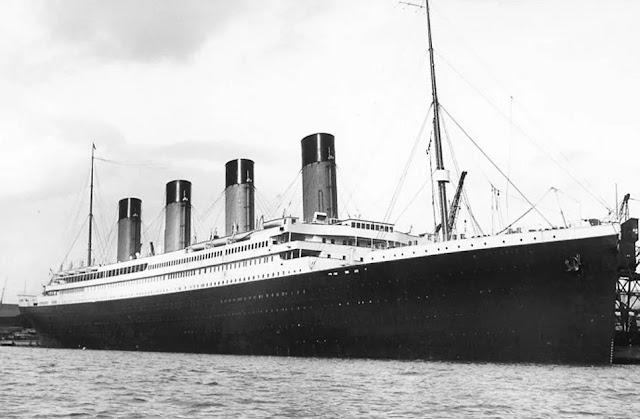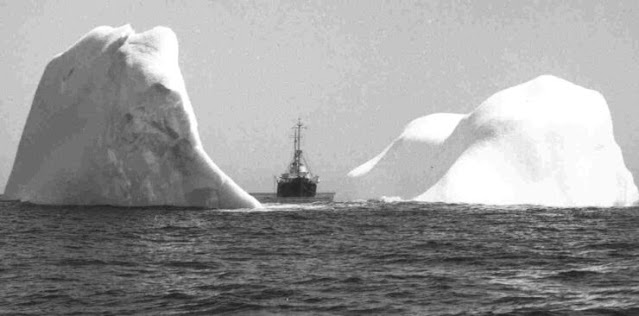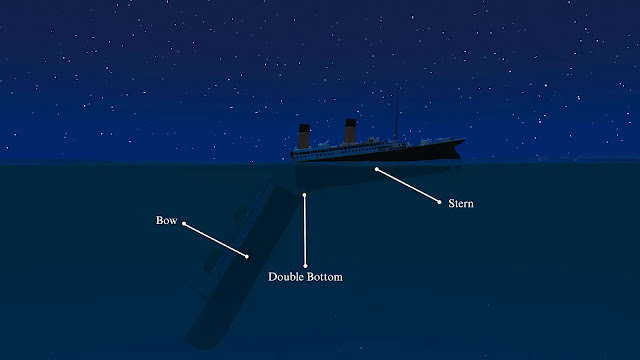 |
| Titanic |
The RMS Titanic, the largest and most opulent Ship, in the world at the time, was involved in this Catastrophe on April 10, 1912. It set out on its first voyage traveling from Southampton, England to New York. People from all walks of life were on board-famous industrialists, actors, and immigrants seeking a better life in the United States.
Captain
Edward John Smith:
It was being commanded by the 62-year
old Senior Captain Edward John Smith. There was a lot of excitement regarding
this ship in the passengers, public and the media. It was not only the world's
largest ship- around 269 meters in length and more than 53 meters high- but the
luxury on this ship was awe-inspiring.
|
Design
Feature |
Description |
|
Length |
882ft 9in (269.06 m) |
|
Breadth |
92ft 6in (28.19 m) |
|
Height |
104 feet (32 m) |
|
Gross tonnage |
46,328 tons |
|
Number of decks |
9 |
|
Number of lifeboats |
20 |
|
Number of passengers |
2,224 |
|
Number of crew members |
892 |
|
First-class features |
Immense dining saloon, four elevators,
swimming pool |
|
Second-class features |
Comparable to first-class features on other
ships |
|
Third-class features |
Modest, but still noted for their relative
comfort |
Titanic Designed:
At the time, the cost of building
the ship was $7.5 million, which, when adjusted for inflation, is equivalent to
$400 million today. The amenities and decor inside the ship could easily be
mistaken for a five-star hotel, with stained glass mirrors, elaborate wood paneling,
two-story, heated swimming pool, Turkish There is a spa, a gymnasium, a squash
court, 4 restaurants, 2 barber shops and a library. In addition, the type of
safety features used to build this ship were considered "unsinkable,"
meaning it could never sink, it was so safe.
White
Star Line Company:
White Star Line was the name of the
company that built this ship. The Vice President of this company was so
confident regarding that, he had come out in front of the public and said that
this ship was unsinkable.
Icebergs
Warning Alert:
But two days later after setting out
on its first voyage, on 12th April 1912, the Titanic began to get its first ice
warnings. The Atlantic Ocean, which the Titanic crossed to reach the Americas,
was full of icebergs. There were mountains of icebergs, that posed a threat to
this Ship. These alerts are not uncommon. Ships that navigate the oceans often
use radio to alert nearby ships that there is ice in their area and they should
exercise caution in their approach after receiving these alerts.
The Titanic swerved twice to avoid a
collision but did not slow down. It continued its journey towards its destination
at a speed of 21.5 knots, which is equal to 40 km/hr, Two days later, on 14
April 1912, there were there were another 7 ice warnings, but Captain Smith and
his team ignored them. They didn’t slow the Titanic’s speed. When the day is
over, the sun goes down and the temperature goes down. The notable thing about
the night of 14th April was that the moon was not visible without the moon,
there was no moonlight and the visibility was low on this night.
There was a crow's nest on the ship- a small platform at a height that could be called a lookout point. Someone is designed to sit on top of it in order to keep an eye on the ship's track to detect any traffic or obstructions. The person sitting here had to face very low temperatures, the cold winds were blowing at a very fast pace Moreover, it was nighttime.
 |
| Crow’s nest in Titanic |
The cold wind causes tears in the eyes, making it hard to see. At 11:39 P.M., Fredrick Fleet was sitting on top of the crow’s nest when he suddenly saw a large iceberg in front of him. He rang the bell three times to alert the people below, then picked up the telephone and called the bridge officers. He screamed that there was an iceberg in front of them and that the ship should be steered.
Titanic crashed with Iceberg:
Immediately First Officer, William heard this
message and signaled the engine room that the ship should be steered in the
left direction But unfortunately, it was too late Just one minute later, at
11:4The 0 PM, the ship crashed into the iceberg.
This iceberg was not a small one- It was 200x400 feet in length- as big
as a football field and was so high that it matched the crow's nest in height. Scientists
estimate that the iceberg weighed as much as 1.5 million tons. Titanic’s front
right side collided directly with the iceberg, which is located at the bow of
the ship.
What
is the bow?
The section at the front of the ship is called the bow. The section above the bow is known as the stern. The protruded section below the stern is known as the keel. The ship scraped against the iceberg for about 10 seconds. A large dent was made. Small holes were made in the main body.
How that is possible? How does a chunk of ice cut through a piece of metal?
If you use the ice in your fridge, then yes, it won't cut through metal But the weight of a mountain of ice is so high. It’s true that wood can’t cut through metal, but that doesn’t mean that metal can’t be damaged. Your metal car might smash into a tree, but it won’t be completely disfigured.
The Titanic was damaged because of the iceberg’s size and weight. Just seconds after the crash, Captain Smith and the ship’s architect, Thomas Andrews, arrived at the scene to assess the damage. As soon as they saw what had happened, they knew that the ship, was going to sink.
They were so shocked, that they thought this ship. It was “unsinkable” due to its impressive safety features.
Double-bottomed Hull
This belief was based on two main safety features. The first was the double-bottom hull. A hull is the main body of a Ship. A double-bottom hull would have two layers. If the layer below were to be damaged, it would be the second layer that would save the ship. Secondly, the ship’s hull was divided into sixteen watertight compartments (16 compartments in total).
If four out of sixteen compartments were to fill with
water, it wouldn’t affect the ship. But the impact created by the iceberg was
on the side of the ship The double bottom hull proved to be of no use The sides
only had one single layer Second- the impact was so large that 6 out of 16 watertight
compartments were breached Water was filling in all of them. The limit was 4, and
the inundation of 6 compartments meant that the ship couldn't be saved from
sinking.
20 minutes after the collision, at 12:00 AM, Captain Smith ordered his crew to send a distress call over the radio. The nearby ships would maybe detect it and come to save them Senior radio Jack Phillips turns out to be the hero of our story One after another, he began sending distress signals- there was no response. He sent another and another. There has to be a vessel somewhere that would respond to their distress call.
 |
| RMS Carpathia |
Passengers used Lifeboats:
In the meantime, Captain Smith told the people on board to get off the boat and into the lifeboats. As per protocol, women and children would be given preference to board the lifeboats, for the passengers on the ship, were not that scared.Most of the passengers believed that Titanic was an unsinkable ship, so there is no need to worry After all, the company that put out ads, claimed this again and again. So yes, they did crash into a glacier, but the boat didn’t sink. That’s why the first life boat went down with 65 people on board. Only 28 people went into the lifeboat. Half of the lifeboat was empty when it went down.
As time went on, the rooms started
to fill up with water one by one. The ship began to tilt Gradually, the
passengers realized that the ship could indeed sink When this realization
dawned, there was chaos and people began to run around in panic By 1 in the
night, so much water had filled the compartments in the front that the bow of
the ship had gone underwater Due to this, the rear part of Titanic surfaced out
of the water. The propellers at the back surfaced out of the water when the
ship tilted to this degree, pandemonium reigned People began to fight with one
another for a seat in the lifeboat.
The problem was there was a scarcity of lifeboats on the ship there were only 20 lifeboats that could accommodate. There were only about 1,200 people on board but there were about 2,200 people onboard at 2:05 AM. The last lifeboat was released from the Titanic but there were still 1,500 people on board. In this chaos, some people tried snatching their place in the lifeboats But some people had accepted their fate and stayed back in the ship 9:47.
Witnesses say the boat split in half at 2:20 a.m. and then started to sink. It took less than three hours for the inflatable boat to sink at 1:00 a.m. The people on board either drowned or perished from hypothermia. The temperature of the water was -2 degrees Celsius If you fall into the water at this temperature, you'd die within minutes due to hypothermia.
Titanic’s captain, Edward Smith, is
said to have remained at the helm until the very end, when he drowned with his
ship. Some people even believe he committed suicide. The ship that was supposed
to rescue the Titanic, the HMS Carpathia arrived at this location between 3:30
and 4:00 AM, to rescue the passengers on board, but it arrived an hour later.
S S Californian Ship near to the Titanic:
After the disaster of the Titanic, questions were raised, many controversies took birth investigations were conducted and some unknown facts surfaced that shocked. Everyone, how would it feel if I said that there was another ship 37 km away from Titanic that night, which could make it in time to save the passengers of the Titanic S S Californian was the ship that issued the final iceberg warning an hour before Titanic crashed into the iceberg. They had warned- Watch out. There are a lot of icebergs in the ocean here after that at 11:15, the radio operator on the Californian ship switched off the radio. The California ship had stopped overnight and was not moving forward with the danger in mind. Since the boat had stopped overnight and the radio had been switched off, it had not received the distress call. The ship was so close to the Titanic that the passengers on the deck of the Titanic could see the ship on the horizon.
 |
| S S Californian |
The next morning when they switched their radio on, they received the SOS calls from Titanic They reached the site but it was too late by then, they only saw dead bodies floating in the water.
The Main causes of the Titanic’s Collapse:
In both of the investigations that were done into this, Captain Lord was found guilty of the crime.
But one single man cannot be blamed
for such a huge disaster Other people were responsible as well Like the lifeboat
example, there were not a sufficient number of lifeboats. The cause for this
was due to the fact that the ship was deemed unsinkable by the manufacturer and
lifeboats were not necessary. Apart from that, the captain of Titanic had not
even conducted safety drills. We had a safety drill scheduled for that day. Titanic
collided with the iceberg but the captain canceled that because he thought they
were unnecessary since the ship was unsinkable.
The next mistake was that of
steersman Robert Hichens, who was at the steering wheel that night when an
iceberg alarm was sounded, The officer on the deck instructed that The ship
should have veered to the left, but in a state of panic, Hichens misinterpreted
the instructions and turned the boat to the right. This was the opposite
direction- towards the iceberg by the time he realized his mistake, it was too
late.
According to the British inquiry, the Titanic was warned so many times to stay away from icebergs and to "be careful" but still went full speed ahead.
Why was that? Why did the captain not slow down?
One of the most popular is that Captain Smith was influenced by Joseph Bruce, the Chairman and Managing Director of White Star Line, the company that produced the Titanic. White Star Line was pushing Captain Smith to maintain the ship's speed. They were pushing him to complete the ship's first voyage within 6 days in order to break a record so that they could demonstrate that the ship was not only the largest, most expensive, but also the fastest.
On April 14th, 1899, Captain Smith saw an ice warning at 2 PM. He was told to reduce the speed as there was an ice warning, but Joseph stuffed the paper into his pocket so that people and crew members would not know. He did not want the ship's speed to slow down.
The International Ice Patrol (IICP)
was established in 1914 so that ships could be warned about icebergs on their
way.
The SOLAS treaty was signed in 1914
and set new standards for ships. For instance, a regulation on lifeboats was
introduced which required ships to have at least one lifeboat for every
passenger.
When the Titanic went down, it took
over 70 years to locate the ship’s wreckage.
Robert Ballad found the Titanic under the sea:
In September 1985, a French oceanographer and an American ocean explorer named Robert Ballad were able to locate the Titanic’s wreckage. The ship wreckage was located, at an underwater depth of 3,800 meters or 3.8 kilometers.
 |
| Robert Ballad |
It is expected that by 2030, this
ship will completely disintegrate underwater Today, even after 110 years, the
fascination regarding Titanic still remains in the minds of people.
Clive Palmer makes Titanic 2:
In 2012, Australian billionaire Clive Palmer planned to he would make Titanic 2 The project was initially, scheduled to be finished in 2016, however, due to delays, it has not yet been completed in 2022. It has been suggested that people are not interested, in this project due to the fact that if a, replica of the original Titanic were to be constructed, it would likely not have either a television or Wi-Fi, and no one would want to take a ride on it. It is possible that the Titanic 2 may have already sunk prior to its departure.
Conclusion:
1.
We all know what happened, when the
Titanic sank into the Atlantic Ocean one hundred years ago. However, it's not
as easy as we might imagine.
2.
People made blunders, there were
limitations in technology, and the ship was doomed before it even departed
Southampton due to greed, corruption, and evil intentions. People deserve
better, and since the future is uncertain, we must learn from our past
transgressions in order to avoid, repeating them going forward. Future
decisions, will be influenced by the decisions.
3.
We make today, so let's make
intelligent, and modest decisions to avoid a repeat of the past.














0 Comments